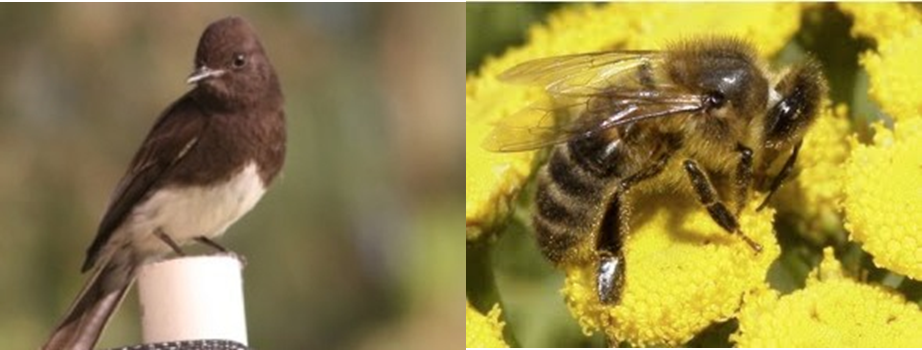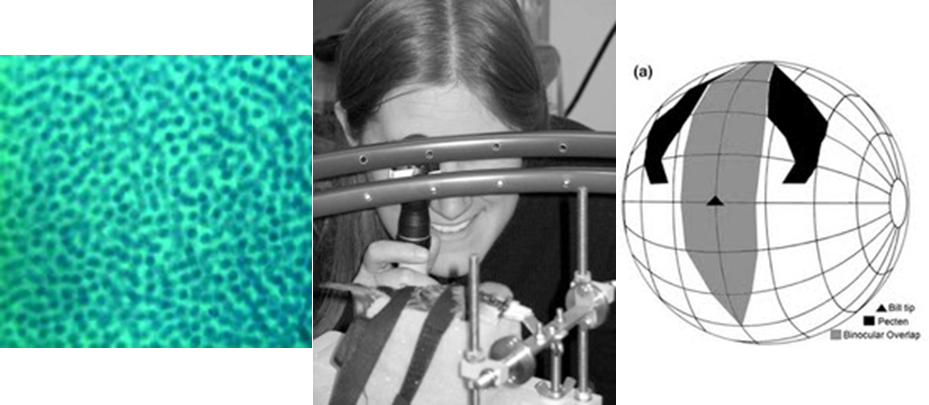Black Phoebes and Their Prey
The Black Phoebe is a small passerine sit-and-wait flycatcher. It is a predator mainly on wasps, bees, and flies, which move quickly in 3-D space. The Black Phoebe rarely misses a prey item, perhaps because it will only initiate a foraging attempt if it is relatively sure it will capture the prey.
The ability of Black Phoebes to locate and track prey items is directly related to visual capabilities, such as visual acuity and visual fields. Black Phoebes may also maximize their success through behavioral strategies, such as choosing perch locations and search strategies that enhance visual capabilities.


Field Studies
We used a variety of techniques in the field to determine how factors that could limit visual perception would affect visual searching for prey items. We first wanted to know if Black Phoebes would choose perches that would improve visibility. We found that they generally choose perches with lower light intensity, but greater grass and tree cover than random perches. We then wanted to know how the conditions at the perch would affect visual searching behavior.
We video-taped Black Phoebes before a foraging flight and determined two proxies of visual searching: hear movement rate and head movement bout length. We also measured tree cover, grass cover, and light intensity at the perch and capture site. Finally, we used a spectrometer to determine the irradiance and the reflectance of a model prey item and the capture site. Using this information and the properties of the avian photoreceptors we determined the chromatic contrast of the prey item against the background.
We found that head movement rate increased with light intensity, tree cover, and when insects were caught in the air. Head movement bout length decreased as grass cover increased. We did not find an effect of chromatic contrast on our proxies of visual searching. Taken together, these results suggest that visual and physical access to prey items can influence the visual searching behavior in a sit-and-wait predator. For more information see the “Publications” page.
Visual Physiology
In the lab we used a histological technique to estimate visual acuity and an ophthalmoscopic technique to determine the visual field of the Black Phoebe. To estimate visual acuity we extracted the retinas, fixed the tissue, and stained the retinal ganglion cells. We then determined the density of ganglion cells in the retina. With this information and the size of eye we could estimate the visual acuity of the Black Phoebe. Although our sample size was limited, it seems that Black Phoebes have relatively high acuity compared to other (and even some larger) passerine species.
The visual field is the extent of space around the head from which visual information can be extracted. We used an ophthalmoscopic technique to determine the visual fields in birds. This is essentially like giving the bird an eye exam. We observed the eyes with a specialized light and determined the extent of the retina. We then mapped this information in 3-D space. We found that Black Phoebes have relatively long binocular extents, although the width of the binocular area is smaller than in ground foraging passerines. In general, the Black Phoebe has a visual field that is most similar to dive-pursuit predators and other sit-and-wait predators. The Black Phoebe can move its eyes, but again the extent of eye movement is not as large as in other passerines. Therefore, in complicated visual situations (e.g. tracking a prey item) Black Phoebes may use head movements to keep visual targets in the line of sight with highest acuity. For more information see the “Publications” page.


